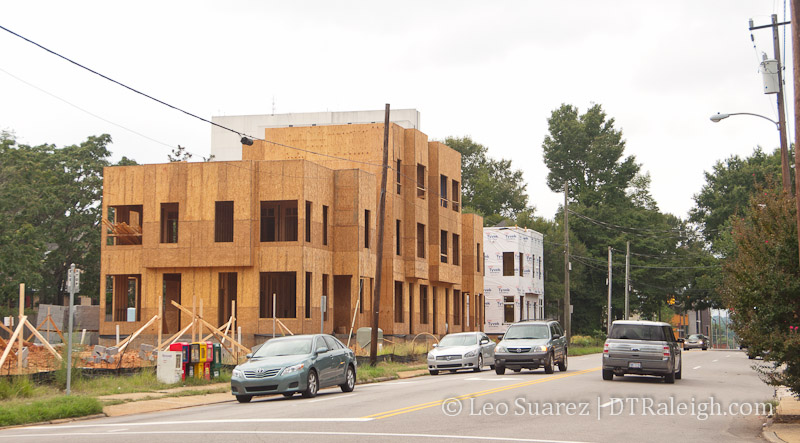
Construction of Peace Street Townes continues. A sign at the site claims, as of last weekend, that only 4 units remain of the 18 unit site.

Construction of Peace Street Townes continues. A sign at the site claims, as of last weekend, that only 4 units remain of the 18 unit site.
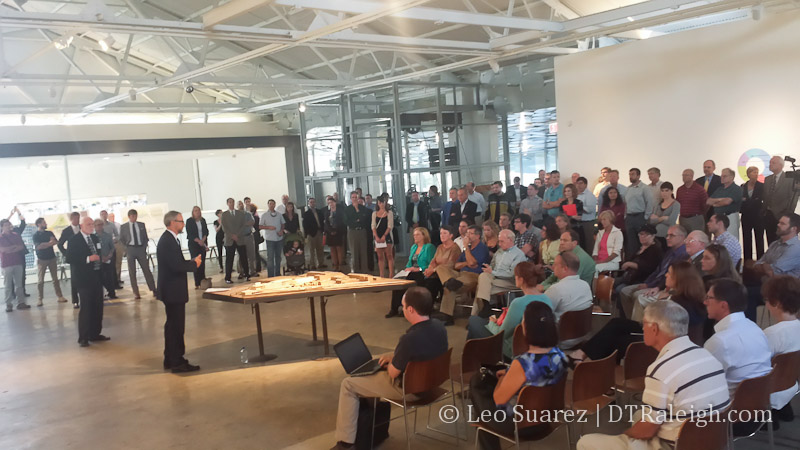
I’m at the Raleigh Union Station meeting and wanted to get this out. The mayor announced a groundbreaking for March 21, 2015.
More to add later.
The meeting tonight was more open house than new information. The groundbreaking announcement was the biggest piece of news and the March 21 date is not an accident. March 21, 2015 is the 175th anniversary of the first train to arrive in Raleigh.
In addition to the already posted renderings, a fantastic model of the Union Station site was on display.
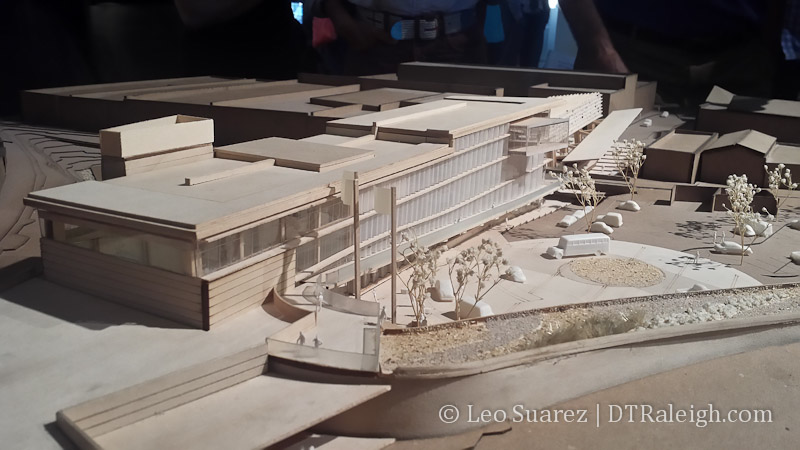
They estimate about two years for construction so look forward to the new station opening sometime in 2017.
[UPDATE: 9-11-14]
For posterity I’m copying the city’s press release on the topic that came out after this event.
On March 21, 1840, the people of Raleigh were witnesses to history. On that Saturday in the spring, a train rumbled into Raleigh for the first time. Over the next century, the era of the locomotive would dominate transportation in the modern world. Eventually, cars and planes would supplant the locomotive. But few inventions shaped the physical destiny on nations like the train.
On March 21, 2015, the people of Raleigh will once again have the opportunity to witness history. On that Saturday, officials will break ground on the first phase of Raleigh’s Union Station, a joint initiative of the North Carolina Department of Transportation Rail Division and the City of Raleigh. The estimated cost of the first phase of the project is $73 million. Current funding for the project totals $66.25 million through a series of federal grants, and state and local matches. The City’s contribution to the construction is $5.75 million. The first phase will include the renovation of the Dillon Supply Company Warehouse at 510 West Martin Street into a passenger rail facility.
Once completed (estimated date of 2017), the station will transform the transportation infrastructure of Raleigh. Not only will the station serve Amtrak passengers, the station will add new retail and commercial office space to its warehouse district location. The station will feature three levels of restaurants, shops and offices, and offer visitors a rooftop view of the Downtown Raleigh skyline.
Throughout the design process, architects from Clearscapes sought public feedback on the aesthetics and amenities. The firm strove to honor the City’s railroad heritage while looking at how other cities have reused warehouses. Planners envision a vibrant, active and economically viable space that benefits rail passengers and creates a new Downtown destination. Upon full-build-out, Raleigh Union Station will serve as a transportation hub for local and regional commuter and passenger rail, buses, taxis, bicyclists and pedestrians.
On September 9, the final public information session at the Contemporary Art Museum gave people a last chance to look at the designs and scope of the project and ask questions of the designers.
“Creating great public spaces, both interior and exterior, are significant goals for this project,” said Steve Schuster, the designer of the project for Clearscapes, PA. “That is very much in line with having this facility be authentic, memorable, and unique. We were very pleased when the national Amtrak architect spent the day with us reviewing the project and remarked at the end of the day that the Raleigh Union Station is, in his view, the most exciting rail station project happening in the nation.”
In 2012, Raleigh’s Amtrak Station served 164,000 passengers, making it one of the busiest Amtrak stations in the southeast. But the location and size of the current train station cannot accommodate the expected increases in ridership. Additionally, the current station only has 1,800 square feet of passenger waiting space and only 54 parking spaces.
“This design solves a lot of longstanding problems associated with this large railroad junction, and does so in a way that creates new opportunities,” said City of Raleigh Planning Director Ken Bowers. “The design respects and builds on what’s special about the warehouse district. The reuse of existing industrial building will result in a unique and dramatic space. The echoes of the area’s rail and industrial heritage are reflected throughout the design. The new plaza creates a signature open space at the terminus of Martin Street that will serve as a focal point for a growing arts and innovation district, and connect pedestrians into the Downtown core. The result will be a gathering place that will be a magnet for not just travelers but also area residents, workers and visitors.”
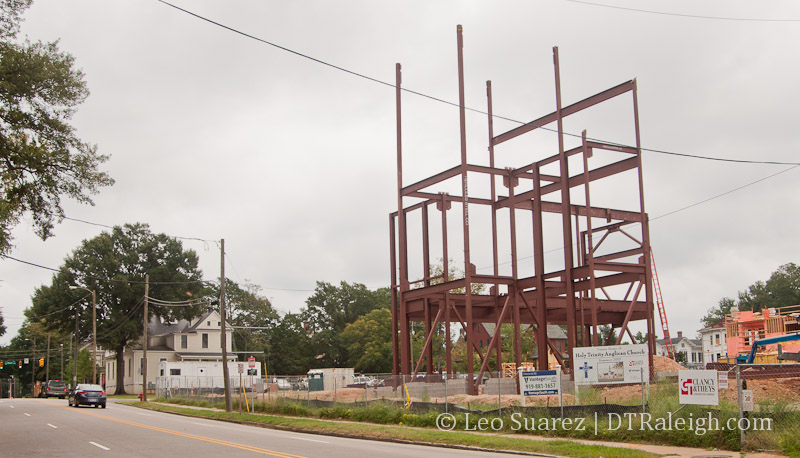
I’m trying to think when the last new church was built in downtown Raleigh? There may be quite a gap between that one and the one being constructed now on Peace Street next to the AIA NC building.
Holy Trinity Anglican is currently located at the house on the corner of Peace and Blount Street next to the church construction site. The building should be finished by September 2015. There’s a nice virtual tour video, embedded below, or on Vimeo. I wish other new developments would release videos like these.
Take the Tour from David Cumbie on Vimeo.

Raleigh’s latest Downtown Plan has been in the works for most of the year. Public input has been collected throughout the Spring and we now have an upcoming draft that will be presented on September 11.
From my inbox to yours:
The draft Downtown Plan presentation will highlight Raleigh’s reputation and identity as a creative, innovative, and family-friendly city. Specific attention will be given to actionable catalytic projects that can accelerate economic progress in Downtown and help link the different districts of Downtown together. Visualizations of the catalytic projects will be created by using 3D models. The presentation will be conducted by the consultant team lead by Sasaki Associates.
*Draft Downtown Plan to be Presented Sept. 11
Date/Time: Thurs., Sept. 11 from 6 p.m. to 8 p.m.
Marbles Kids Museum
201 East Hargett Street
Raleigh, NC 27601
919.834.4040
Date/Time: Fri., Sept. 12 from 9 a.m. to 5 p.m.
City of Raleigh Museum
220 Fayetteville Street
Raleigh, NC 27601
919.996.2220
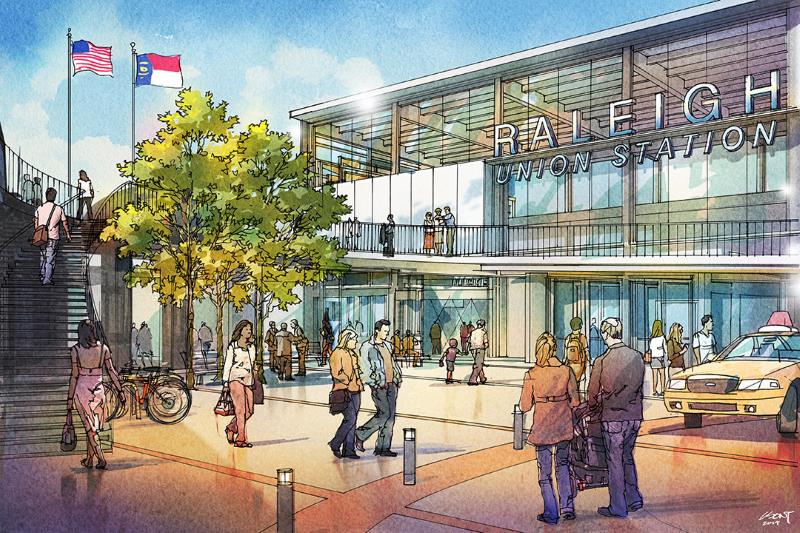
The Raleigh Union Station project has been one of the most publicly accessible projects that has come through the city in the last few years. The final public session is next week so make sure to catch up with the previous blog coverage and come out to CAM on September 9.
Date/Time: Tues., Sept 9 from 6 p.m. to 8 p.m.
Contemporary Art Museum
409 West Martin Street
Raleigh, NC 27603
919.513.0946
I’m going to recommend that a Raleigh flag be put up with the USA and NC flag like in the rendering above.

One of downtown Raleigh’s hot topics this year has apparently been the R-Line. If you’ve been following, there are a slew of stories about the perceived unfairness of the fare-free bus circulator that operates seven days a week. With upcoming fare increases on other routes of the Capital Area Transit (CAT) system, the R-Line is being looked down upon by certain Raleigh individuals.
My take on this is that the R-Line is being politically micro-managed and we should let the transit planners have a say.
Background articles to read:
The route was first introduced in February of 2009 with a dedication ceremony in front of the Raleigh Convention Center. It’s important to note that the R-Line was one piece of a much larger puzzle. The Convention Center had just opened around that time. The Fayetteville Street makeover was still pretty fresh. City Plaza was less than a year old.
These were downtown improvements made to attract more visitors, create more spending, and create more businesses. From a city point of view, that means paying back the investment in downtown and generating more tax revenue. Cities do this to sustain a high-quality of life, which Raleigh has, with a fair or low cost of living.
A lot has happened over the last five years though.
Events have been one of the largest driving forces behind downtown Raleigh’s growth. Fayetteville Street events used to close off one or two blocks. Moore Square events could be contained within the park itself.
Today, downtown is bursting with events.
An interesting statistic would be the growth of attendance and size over the years. I would put money down that that number has increased year after year.
You have a pretty good chance of catching an event on Fayetteville Street on any given weekend these days. From mid-August to mid-October, downtown is crawling with events and people. Spring has another spike in events that seem to take over. Parking decks are as or more full on weekend nights as they are during the workweek hours any weekend of the year.
It also seems that every marathon that comes to town wants to run their route through downtown Raleigh. We’re not talking just a few, but several dozen closing streets on random weekends.
So what does the R-Line have to do with downtown being the host with most?
A strategy (the R-Line) to make our public investments (Convention Center) more attractive became hugely successful and everyone wants to get a piece of it.
And why was it successful? In my opinion, the R-Line is run like most bus routes should be run. No timetables and a higher frequency of buses passing by.
It was also the first city bus route, to my knowledge, in Raleigh to have GPS tracking. Those with smartphones could see the bus location before heading out to the bus stop. With all the amenities and ease of use, it was implemented very well and has become successful.
Over the years, Raleighites have adopted it. The original purpose is still intact, with the buses moving conventioneers around downtown. The event-driven downtown has used it for moving people between venues. The growing resident population has used it to travel between districts. With a stop near the Moore Square Transit Center, CAT riders have also used it as either the first or last leg of their trip when getting around.
With a diversity of riders, sounds like a success story to me.
Today, the R-Line’s fareless system is being picked on. With an upcoming 50-cent increase in fares over the next 2 years on every other CAT route, there are some vocal citizen advocates that think this unfair, with one individual quoted in an N&O article calling the R-Line racist.
Opinions and proposals on the R-Line aren’t hard to find either.
The articles linked above mention issues such as fairness, equity, and cost. Expanding the route would cost more. How can you make the R-Line more fair? Should all riders have equal access and the demographics of riders be diverse?
We’ve definitely lost sight of the original purpose of the service, which is to move visitors (from hotels and the convention center) around downtown.

What we have today though is a situation where the R-Line is so successful that groups want to either copy the R-Line model or modify the current route to include their neighborhood or business, with complete disregard to the overall system that the R-Line is a part of.
In 2013, the Midtown Raleigh Alliance teased an idea of an M-Line between North Hills and Downtown Raleigh. I wrote about the idea and how it compared to the currently in place Route 8 – Northclift CAT route. They seem similar.
In 2011 and back again this year, Cameron Village and nearby residents are petitioning to change the R-Line route to serve the shopping center and the neighborhoods around it. I wrote about it back in 2011, and it’s pretty applicable this year too, that Route 12 – Method and Route 16 – Oberlin both have been providing a link to and from Cameron Village for years.
You also have residents in Oakwood and Mordecai that think the R-Line should swing more north to serve the growing Person Street District. In the linked articles, there are opinions that the R-Line should go more east instead of turning around Moore Square only. CAT routes serve those communities today.
Finally, I’ve heard that the upcoming 10-year Downtown Plan has a pretty healthy section on the R-Line. The draft release of that is scheduled for September 11, blog post on that soon.
It seems the R-Line has now become politically infested. It works so well that others are upset that it isn’t serving their communities. I predict any outright support for the R-Line would be seen as a politically bad move at this point.
I wrote this in the 2011 post about the R-Line going to Cameron Village:
“In my opinion, the petition just shows this area’s readiness for an upgrade in transit “
Raleigh, you are ready to level up. It is time to put on your big girl pants and commit to moving CAT to the next level.
Raleighites should stop picking on the R-Line and start getting behind seeing more money in the budget for the CAT system. Raleigh should hire some top transit talent to guide us in moving to the next level.
With a cohesive and easy to use transit system, funded by all Raleighites, priced fairly for the service it provides, we will stay on the top 10 lists for decades to come.
Saw this on Twitter. This project is increasing in height it looks like.
The Edison Office in #DowntownRaleigh for @BeaconCLT pic.twitter.com/AT7A8c2F4A
— JDavis Architects (@JDavisArchitect) August 28, 2014
Throwing a tweet of mine up here on the blog for posterity.
Downtown living is still an extreme niche. As we hit 1 million in the county, still less than 10,000 in DTR. That's 1%.
— Leo Suarez (@dtraleigh) August 22, 2014
And then let me add a little more statistics. According to a 2014 report from the Downtown Raleigh Alliance, we get this nice graphic.

Click for larger